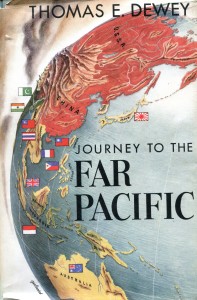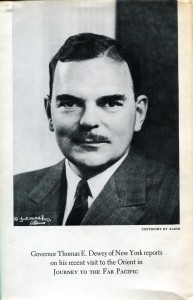A curious thing: I’ve been self-employed for 10 years as of today. When I got to my office on the morning of April 14, 2005, I found that the company’s HR woman had come in from New York — and so had the publisher. I didn’t appreciate it at that moment, but I’m glad they had the good graces to fire me in person.
 Here’s something I found in a resale shop the other day. Odd what you can get for $1.
Here’s something I found in a resale shop the other day. Odd what you can get for $1.
Published by Doubleday & Co. in 1952, Journey to the Far Pacific is a forgotten tome by Republican politico Thomas E. Dewey, who (considering the country’s disregard of its own history) is at some risk of being forgotten himself. Then again, he’s probably one of the better-known presidential election losers. If you’re going to lose, do it in a surprising, spectacular way.
The book’s blurb notes: “A few months ago New York’s Governor Thomas E. Dewey set out on an extensive tour of the Orient to view conditions at first hand and to form for himself impressions of the peoples and nations who stand between Communism and the California coast. During his trip he traveled forty-one thousand miles, visiting seventeen republics, kingdoms, territories, and colonies.”
The book’s maps are interesting. Of course they are. Note that on the cover, communist-controlled territory is red-orange, including half of the Korean peninsula but not Taiwan, which naturally is called Formosa.
The map that illustrates the main title page shows the “Chinese Republic” as including all of the modern PRC except Manchuria — which is separated as if it were independent — as well as Mongolia, which is merged into China as if it weren’t independent (it was a Soviet satellite, but still technically independent in the early 1950s). Ulaanbaatar is called “Urga.” It’s easier to spell, anyway.
 Unfortunately, there’s no index to look things up conveniently. Not sure when I’ll get around to actually reading the thing, but for now owning it’s enough.
Unfortunately, there’s no index to look things up conveniently. Not sure when I’ll get around to actually reading the thing, but for now owning it’s enough.
Dewey’s on the back cover. I never appreciated how oval his head was. There’s a monograph in that somewhere: head shapes of the men who ran for president. Maybe one shape or another tends to win.
That’s a Yousuf Karsh photograph of Dewey. Not one of his better-known images. Not bad, but it doesn’t have the luster of some of his more famed shots. Then again, maybe it was hard to make Dewey look like he had even an ounce of charisma.